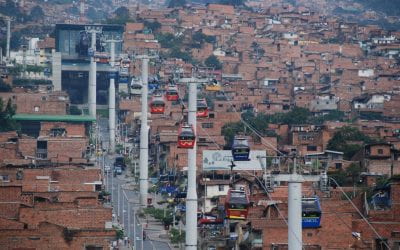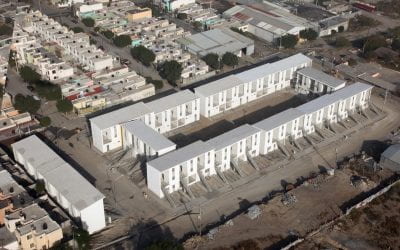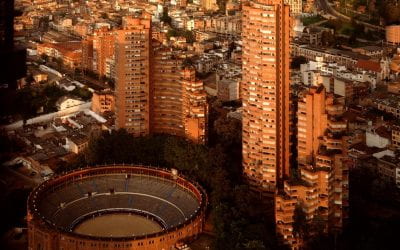On Conflict Resolution
Quality Design Matters
Throughout Latin America, divisions and conflicts in the first decade of the 21st century have separated countries, communities, friends and family members, adding to the polarization and confrontation among informal settlers, informal and formal residents, and among formal dwellers. Cities are being pulled apart by gated communities. Houses are fenced and/or walled, and/or protected with bars on their doors and windows, both in formal and informal settlements.
A polarized world between the haves and the have-nots has increased violence and crime fueled by resentment. Some of the most important problems worldwide are crime, citizens’ safety and corruption, as Foreign Policy editor Moisés Naím observed in a November 11, 2009, article in Spanish daily El País. In Latin America with its rampant pseudo-populism and vast differences in educational and economic levels, most cities epitomize tensions expressed in spatial and social order, as most notably documented in the Urban Age Project by the London School of Economics and Deutsche Bank’s Alfred Herrhausen Society (The Endless City, Phaidon Press Ltd., London, 2007, p.11).
In order to minimize conflicts and violence, and bring down fences and walls of separation and misunderstanding, quality design matters. In terms of medium and long-term goals, quality design helps shape educational, health, and socioeconomic programs. In the short run, much can be done in the urban scenarios: quality urban planning and design affecting the public realm, as well as good architectural solutions particularly in housing and services. These aspects can play a key role in diminishing physical barriers, thus contributing to a reduction of tension and discrimination. Radical change can be accomplished through a commitment to carry it out with a clear and transparent plan and strategies to reach goals in a timely manner.
What does quality design means in cities of developing countries? Let’s start by saying that what is good for the more fortunate is also good for the less privileged. We will elaborate on this issue.
A GLIMPSE AT TRENDS IN LATIN AMERICAN CITIES
Violence is mostly manifested in urban areas for obvious reasons: half of the population already is living in cities, and three out of every four people will be living in cities in 2050. In Asia, Africa and Latin America almost a billion people —one sixth of the world population and one third of urban dwellers—live in informal settlements. By 2020, an estimated 1.4 billion people will be living in slums and two billion by 2030. In many cities the population living in informal settlements is larger than those living in formal areas: one third in São Paulo, one fifth in Rio de Janeiro, two thirds in Mexico City and over a half in Caracas, according to the United Nations Human Settlements Programme, The Challenge of Slums: Global Report on Human Settlements. UN-Habitat, 2003.
In Venezuela, for instance, between 1999 and 2008 there were 101,141 violent deaths. That translates into 28 people per day. Official Caracas police figures show that there were 4,160 murders in 2006 —130 for every 100,000 residents, the latest year for which statistics were available. What this means is that urban violence is almost three times higher than the national average. This figure is more than twice as many as Cape Town, South Africa, which is the next most violent city with 62 murders per 100,000 inhabitants (South Africa, The Good News, “Violent crime rates down, but still high,” July 2, 2008. Declarations by Safety and Security Minister Charles Nqakula).
Fortunately, violent crime has decreased considerably in a few cities in Latin America. For instance, in 2001 Medellín in Colombia was considered the most violent city in the world. In 2007 the homicide rate went down to 34.5 out of every 100,000 people (654 homicides total), one of the lowest in the region. The homicide rate went up 33% in 2008, bringing the figure to 871 (Indicadores de derechos humanos y DIH Colombia. 2008 Programa Presidencial de Derechos Humanos y Derecho Internacional Humanitario, p.58. Observatorio del Programa Presidencial de Derechos Humanos y DIH Vicepresidencia de la República, Colombia).
Bogotá has followed a similar trend, although it has managed to keep the homicide rate from rebounding. The common denominator in these two cities has been the transformation of the city fabric by the introduction of quality design components citywide as part of a comprehensive program. Many cities worldwide, without such crime rates, have carried out urban revitalization programs, always using the public space as the main component for the introduction of changes: Lyon in France, London in Great Britain, Providence in the United States, Buenos Aires in Argentina, to name a few examples.
In the case of Medellín, it took citizens with the leadership of the Mayor’s Office only four years to turn the city around. “Medellín, the most educated city” program included: (i) new urban projects under social management to coordinate different institutions and community participation—both new public spaces and buildings were to promote social interaction; (ii) a program solely oriented to the construction of new educational facilities and the rehabilitation of existing ones; (iii) Integrated Urban Projects (PUI) to provide, within specific areas, connections, transportation (including the use of cable-car gondolas to reach barrios on hillsides), open space, and other city components within informal settlements to minimize crime and violence; (iv) social housing for low-income people; (v) a plan of paseos, emblematic avenues and linear parks to weave the city together favoring transportation and spaces and building for cultural development (http://www.medellin.gov.co).
Clearly, there is a direct correlation between quality urban spaces and decline of crime. And availability of quality city spaces means accessibility for a quality urban arena with a high degree of social interaction. However, Medellín is a city of 3.5 million inhabitants, Bogotá of about 7.0 million people, with roughly 40 percent of them living in informal settlements. This is an insignificant number when compared with the task ahead of 1.4 billion in 2020 or two billion in 2030.
RECONCEPTUALIZING THE PUBLIC REALM
There is a need to reconceptualize what a public space should be in these particular circumstances. Clearly, it is essential to provide accessibility, community services, infrastructure (water, sewage, drainage, electricity, and garbage collection, public illumination, and open spaces, educational, recreational, medical, and sport facilities) in a timely, sustainable and financially sound manner in the so-called informal settlements. But, all these interventions must provide for connectivity to and from the formal settlements, so social interaction between different social groups (currently not very welcome) can occur.
Quality design means public spaces or structures that would invite non-residents to penetrate other neighborhoods that facilitate exposure to different parts of the city, bringing accessibility to metropolitan uses spread around the city. Cultural, sport, and medical facilities with distinctive characters should be found in all urban areas, thus breaking stigmas and bridging divisions.
Some people will need to be displaced to make room for these new facilities. However, disruption should be minimized by agglomerating as many infrastructure services along with transportation (accessibility) since the introduction of accessibility is also an easement not only for supplying these services but for its maintenance.
The scale and pace required for providing solutions is a real issue that we need to address right away. How do we capture externalities related to the provision of accessibility? Furthermore, including infrastructure services (water supply and waste-water systems, garbage collection, electricity and gas) along with quality open space can minimize temporary disruptions and speed up the process. For instance, we should consider three-dimensional structures that could accommodate all the necessary infrastructure and accessibility needs for an informal settlement. This type of structure would touch special places where connectivity within informal and formal settlements can provide for leisure open spaces that will lead to facilities and other means of transportation. Furthermore, swapping formal facilities into informal settlements and vice versa can encourage social integration. These should be complementary but they should never be duplicated at either end. Leading people from one end to the other is a goal for reducing social friction and integrating different members of the society in conflict.
We are now entering the second decade of the 21st century. Concerns about global issues have promoted research on sustainability and low emission energy sources, on preservation and recycling, and on more efficient and nature-conscious processes using available resources. What has been labeled as trash for decades now is a means to produce energy. In general, the perception of cities is shifting from a polluting and waste-generating place to a wealth-producing conglomerate of alternative sources of energy, of products for agricultural purposes, and other “green” ends, when seen as one component of a larger hinterland (the ecological footprint of a city within its region), as Venezuelan environmental consultant Arnoldo J. Gabaldón writes in Desarollo sustentable, la salida de América Latina (Grijalbo, 2006, pp. 379, 392). Transportable photovoltaic cells located on-site can soon replace the need for wiring a city for electricity. Processes for recycling local rain- and used water, conveniently located within open spaces of the urban fabric, will soon be a simple, financially accessible solution for many. Local community participation in the construction and maintenance of these new infrastructure facilities will be both a byproduct and a requirement. The more the sense of community, the less the room for violence and confrontation. Virtual three-dimensional representation can provide for testing, community participation, and solving problems before quality design construction starts. Hopefully, we will be witnessing in the near future technological advancements that can help us come up with less expensive, more sustainable, and faster solutions for dealing with qualitative and quantitative urban matters.
THE POLITICAL DIMENSION
This type of interventions would require political will, community support, and a great deal of negotiation due to the conflicting and almost irreconcilable positions among the actors. Therefore, strong legal support and forceful stances would need to be set in place. Involving the private sector, community representatives, public leadership, and a clear and consistent and transparent informational program are required.
In theory, everyone wants a more secure and livable city. However, the means to accomplish that goal are not politically favorable in the short term. No one on either side of the social spectrum would favor integration in the name of security when each side has been doing everything possible to isolate themselves from others; there is also the issue of a loss of privileges and habits in order to accommodate new public spaces/connectors. For instance, in Bogotá, sidewalks (municipally owned) and front setbacks of buildings (privately owned) had traditionally been taken over to park cars. The Mayor’s office decided to recuperate ownership and give public space back to pedestrians by rebuilding all sidewalks with double the height, so cars could not climb up. A citywide protest almost stopped the program. However, after pedestrians started to enjoy walking their city and traffic improved, private owners started integrating their front setbacks to the sidewalks. In a matter of months the city transformed from car-oriented to a pedestrian-friendly mode. Wider sidewalks, new uses in building at street level, open cafes and restaurants soon changed the way people experienced the city.
THE PSYCHOLOGICAL DIMENSION
Integration in the urban realm requires interventions both in the informal and formal areas. Certainly, the formal city enjoys a greater deal of services, infrastructure and amenities. Most cities in the developing world have experienced rapid growth, creating a great space for improvement by incorporating new urban components favoring the public realm. Therefore, solving urban problems in cities with such degree of conflicts demands interventions in both formal and informal settlements since, in most cases, physical and psychological barriers constructed over decades do not provide for connectivity. Not only in the in-between spaces but well inside both worlds there is space for intervention and, therefore, social interaction.
Good design will not necessarily do away with all radical and intolerant positions. However, it will go a long way toward resolving conflicts. Good design matters.
Spring | Summer 2010, Volume IX, Number 2
Oscar Grauer is a professor, founder, and first Chairman of the Urban Design Master Program at Universidad Metropolitana in Caracas, Venezuela. He holds two degrees from Harvard University, and was 2001 Cisneros Visiting Scholar at the David Rockefeller Center for Latin American Studies. He directed the team appointed by the Venezuelan Government to manage the recovery efforts after the disastrous 1999 floodings in the Litoral Central de Venezuela, and has practiced as an urban designer, mostly in Latin America. He is currently working on his next publication: The Role of Public Space in Conflict Resolution.
Related Articles
Architecture: Editor’s Letter
For years, readers have been commenting on the printed edition of ReVista: “How beautiful!” Now here’s a website to match, thanks to the efforts of the design firm 2communiqué and Kit Barron of DRCLAS. It’s not only a question of reflecting the aesthetics of the printed…
Working in the Antipodes
I was asked by ReVista to write an article on my own work, specifically about the fact that I do simultaneous work on social housing and high-profile architectural projects, something that is, to…
Three Tall Buildings
I used to hate the three tall towers that thrust against the verdant mountains. I used to think that the red brick towers dug into the landscape, belonging to some other city and some other space, created a scar of modernity…





